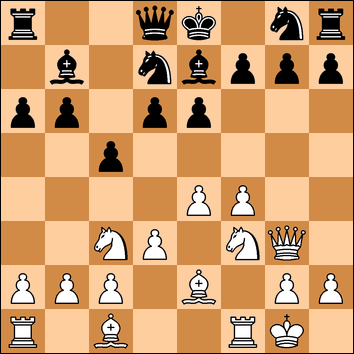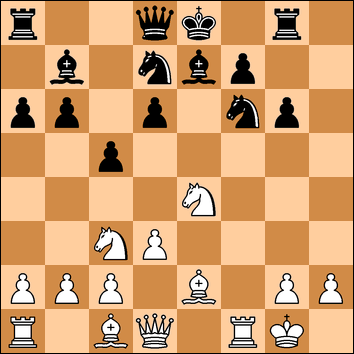Swale Club Chess Championship - Round Eight
Thursday 29 November 2018
White: Keith Nevols (163) - Black: Kevin French (95)
Sicilian Defence
1. e4 c5
2. Nc3 e6
3. f4 Be7
4. Nf3 d6
5. Be2 a6
6. O-O b6
It looked strange to see this played with .. a6. I had expected b5 with a plan to go to b4. 6. . Nc6 and then Nf6 with castles to continue developing would be a better plan.
7. d3 Bb7
8. Qe1
Part of the system I am playing with White is that I can attack the Black king wherever he ends up. At the moment though Black has delayed this so I am not sure where he is going.
8. ..... Nd7
9. Qg3

I could not resist this annoying move. Black must begin to get concerned over his development. I expected 9. .. Bf6 where the computer recommends 10. f5 exf5 and then 11. Qxd6 or a pawn sacrifice with 11. Bf4 Bxc3 12. bxc3 fxe4.
9. .... g6
With his king still in the centre I decided the following was worth a punt - even if it lost me a pawn.
10. f5!? exf5
11. exf5 Ngf6?!
After 11. .. gxf5 I was debating between 12. Ng5 and 12. Qf4. Black however does not want to take the pawn.
12. fxg6 hxg6
13. Ng5
I considered 13. Bf4 but that walks into 13. .. Nh5.
13. ..... Rg8
I assumed the plan here was to play 14. ... Nh5 so that 15. Bxh5 gxh5 leaves the rook placed well.
14. Nge4
Now I need to get the bishops into the game, so after the expected 14. .. Ne5 I was considering 15. Bf4.

14. .... d5?
But this is a mistake, which allows me to keep his king in the centre of the board.
15. Nd6+! Bxd6
16. Qxd6 Qb8?
If 16. ... Qe7 I had 17. Qc7 in mind. Black could try 16. .. d4 where White has the interesting 17. Re1 or 17. Bg5.
Black's mistake gives me a material advantage - which I nearly did not accept. Although removing the two knights seemed a good idea, I was unsure about letting a rook go, and briefly considered 17. Bf4, which would have been a big mistake, as after 17. .. Qxd6 18. Bxd6 d4, all White's advantage has gone. The king might get stuck in the middle, but without queens this is not so important.
Fortunately I kept with plan A.
17. Rxf6 Nxf6
18. Qxf6
I was confident now that the game was won. If Black had played 18. .. Qd8 then I was intending to keep the queens on with 19. Qf4. The move Black plays though ends the game immediately.
18. ... b5
19. Bg5 Qc7
20. Bf3 Bc8
21. Nxd5
The only way to stop immediate mate on e7 or d8 is 21. .. Qd7 and then 22. Re1+ will mate very soon, so Black resigned.